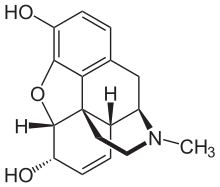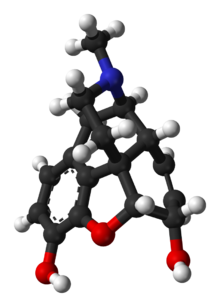Structural Biochemistry/Morphine
Introduction
[edit | edit source]Derived from the juice of the opium poppy Papaver Somniferum, morphine makes up about 10% of the plant's juice and has been used for thousands of years to relieve pain of all types and varying severity. Until it was isolated in 1806, it was ingested as the dried juice called opium. Whether in opium or by itself, injected, smoked or swallowed, morphine binds to receptors in the brain to create feeling of euphoria, which makes it popular for recreational use. In the gut, it binds to the same receptors and slows peristaltic movement so well it remains an unparalleled treatment for diarrhea. As with any opiate, prolonged users will eventually become addicted and tolerance — increasing doses needed to achieve the same effects — can be expected both to analgesia (pain relief) and the euphoria (high) morphine produces.
Although indispensable as a weapon against pain, relief comes with "side effects" that may not be so welcome, especially sleepiness, blurred vision, constipation, and decrease in appetite. Of course, morphine's potential to cause physical dependence ("addiction") is its worst unwanted effect as withdraw symptoms can be pretty unpleasant should the person abruptly stop or sharply reduce their dose of morphine.


How Morphine Works
[edit | edit source]Morphine can be administered several ways: IV drips, orally as a pill, injection, nasally (insufflation), or rectally; each method has its own degree of effectiveness, with the pill form being the least effective (10-30%) and IV drips being the most effective (close to 100%). It works by binding the mu-opioid, the kappa-opioid, and the nociceptin receptors in the brain and spinal cord (mostly on substantia gelatinosa, where the feeling of pain is first processed), as well as the delta-receptors in the brain. It inhibits that transmission of signals from pain neurons in the peripheral nervous system and also produces effects in the dorsal horn to excite neurons and other pathways. The result is that morphine blocks pain signals from both the central and peripheral nervous systems. Ironically, the drug doesn't stop the transmission of pain, but rather alters the user's perception of the pain; they are aware of the pain but find its manageable or it can be ignored.
As little as 5mg of morphine can produce noticeable affects as the drug binds to the same receptors that endorphins, enkephalins, and dynorphins bind to — these opiate-like substances produced naturally by the human body.
The euphoric effects morphine produces are part of another mechanism involving the gamma-aminobutyric acid (GABA) inhibitors and their respective neurons. Under cellular conditions, GABA reduces the amount of dopamine, a neurotransmitter in the brain that is associated with pleasure, released in the brain. Morphine inhibits the amount of GABA that is released in the brain. Over time, it gradually increases the levels of dopamine the brain, which results in a "high" or euphoric feeling.
In addition, prolonged use of morphine inhibits the production of cyclic adenosine monophosphate (cAMP). When morphine suddenly becomes unavailable, the human body produces more cAMP as a results, which leads to hyperactivity and drug craving.
Adverse Effects
[edit | edit source]Addiction
[edit | edit source]The use of morphine is well-known for causing "addiction" — physical dependence. Psychological addiction is also possible but a different concern caused by factors less concrete than the far better understood phenomenon of physical addiction, especially to morphine.
Physical dependence, when a given dose becomes a daily necessity to avoid unpleasant "withdrawal syndrome" symptoms, is a feature of morphine use that can be expected to occur in virtually anyone who takes it for long enough. How long this takes varies within a fairly narrow window but it isn't very likely within the usual week or ten-day period most people will have it prescribed to them. After that, it should be discussed with a physician to prevent needless suffering caused either by untreated withdrawal or from the unwarranted cessation of pain relief treatment for fear of "addiction."
Physical dependence occurs with the other opiate drugs, too, although to different degrees in terms of the severity of withdrawal and development of tolerance to the drug.
Constipation
[edit | edit source]As an opioid, morphine has the tendency to act upon the myenteric plexus, which is in the intestinal tract. This results in the reduction of gut motility, which cases an overall effect of constipation. Morphine decreases the rate of intestinal transit by inhibiting the process of peristalsis of the intestine.
Tolerance
[edit | edit source]Tolerance to morphine occurs very readily, meaning that a higher concentration of morphine is necessary to obtain the same feelings or effects. Hypotheses of how this tolerance develops include the change in the receptor conformation of phosphorylation, the decoupling of receptors of G-proteins, the upregulation of the cAMP pathway, and μ-opioid receptor internalization.
Withdrawal
[edit | edit source]Morphine withdrawal progresses as follows, roughly broken down according to symptoms, their onset and likely duration:
- Stage 1: Pronounced desire for the missing drug ("craving") and anxiety; starts six to twelve hours after the last dose.
- Stage 2: Along with craving and anxiety (which may become stronger) typical symptoms are sweating, runny nose, yawning, and watering eyes ("lacrimation"). Usually starts within about 8 to 12 hours after last dose
- Stage 3: General feeling of being uncomfortable, aching all over the body and loss of appetite are typical as symptoms progress. At this point muscle spasms, especially in the legs, are the origin of the term "kicking" (originally to describe opium withdrawal and later to giving up any other habit) and abdominal cramping are the next symptoms to appear next, about 24 hours after the last dose.
- Stage 4: This is the acute stage when symptoms are at their worst and can last two or three days before subsiding. The pain continues, especially in joints. Insomnia, nausea, vomiting, diarrhea, are typical symptoms although they vary quite a bit — between individuals and between attempts to "kick". Men sometimes ejaculate involuntarily. Severe depression is also a very common symptom.
Deadly Combinations/Precautions
[edit | edit source]Morphine is a potentially dangerous drug because, along with pain relief (analgesia) it depresses breathing. This effect increases with dosage but is also affected by tolerance so it is only a danger in case of overdose or when combined with certain depressants, like alcohol.
References
[edit | edit source]"THE BRAIN FROM TOP TO BOTTOM." THE BRAIN FROM TOP TO BOTTOM. Douglas Hospital Research Centre, n.d. Web. 28 Oct. 2012. <http://thebrain.mcgill.ca/flash/i/i_03/i_03_m/i_03_m_par/i_03_m_par_heroine.html>.
"Morphine." Drugs Forum. Web. 28 Oct. 2012. <http://www.drugs-forum.com/forum/showwiki.php?title=Morphine>.
"Morphine." Information from Drugs.com. N.p., n.d. Web. 28 Oct. 2012. <http://www.drugs.com/morphine.html>.
"Morphine." Morphine. N.p., n.d. Web. 28 Oct. 2012. <http://www.emsb.qc.ca/laurenhill/science/morphine.html>.
# "Morphine Addiction Withdrawal Symptoms and Treatment" <http://www.rehabinfo.net/morphine-addiction/#stages>